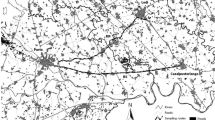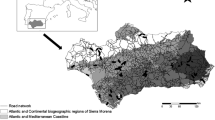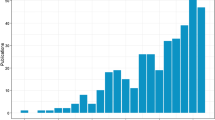Abstract
Road mortality due to animal vehicle collisions has serious negative effects on population viability, demanding urgent implementation of mitigation measures where most required. Data from roadkill surveys is generally used to choose the best mitigation measures, but there is a lack of knowledge about the sampling intensity required for surveys to effectively detect roadkill patterns. Improving the cost-effectiveness of road surveys could free up limited resources that, in turn, could be used to obtain a better perception of road impacts and mitigation effectiveness elsewhere. We evaluate the possibility of improving road survey cost-effectiveness by comparing the spatial patterns obtained when using a weekly versus monthly survey and year-round versus seasonal surveys. We analyzed a roadkill dataset, previously collected over 2 years in southern Brazil, and applied two criteria for assessing the effectiveness of two alternative survey protocols: tradeoff between sampling effort and sample size; and similarity in spatial patterns. We found support favoring monthly surveys for those taxa in which roadkill was not markedly temporally clustered, as was the case for larger mammals. However, performing weekly surveys over shorter periods may significantly improve cost-effectiveness for taxa with peaks in mortality if surveys are performed during those periods when roadkill is most likely to occur. We suggest applying a mix of sampling protocols, with intensive surveys during warmer periods for reptiles and other taxa with peak roadkill at these times while, for the rest of the year, a monthly survey could be used to improve detection of rarer species.




Similar content being viewed by others
References
Ascensão F, Grilo C, LaPoint S, Tracey J, Clevenger AP, Santos-Reis M (2014) Inter-individual variability of Stone Marten behavioral responses to a highway. PLoS ONE 9:e103544
Bager A, da Rosa C (2010) Priority ranking of road sites for mitigating wildlife roadkill. Biota Neotrop 10:2–7
Bager A, da Rosa C (2011) Influence of sampling effort on the estimated richness of roadkilled vertebrate wildlife. Environ Manag 47:851–858
Balkenhol N, Waits LP (2009) Molecular road ecology: exploring the potential of genetics for investigating transportation impacts on wildlife. Mol Ecol 18:4151–4164
Beaudry F, DeMaynadier PG, Hunter ML Jr (2010) Identifying hot moments in road-mortality risk for freshwater turtles. J Wildl Manag 74:152–159
Beebee TJC (2013) Effects of road mortality and mitigation measures on amphibian populations. Conserv Biol 27:657–668
Blazek R (2005) Introducing the linear reference system in GRASS. Int J Geoinf 1:95–100
Borda-de-Água L, Navarro L, Gavinhos C, Pereira HM (2011) Spatio-temporal impacts of roads on the persistence of populations: analytic and numerical approaches. Landsc Ecol 26:253–265
Borda-de-Água L, Grilo C, Pereira HM (2014) Modeling the impact of road mortality on barn owl (Tyto alba) populations using age-structured models. Ecol Model 276:29–37
Bowman AW, Azzalini A (1997) Applied smoothing techniques for data analysis. Oxford University Press, Oxford
Bowman AW, Azzalini A (2014) R package “sm”: nonparametric smoothing methods (version 2.2-5.4). URL: http://www.stats.gla.ac.uk/~adrian/sm, http://azzalini.stat.unipd.it/Book_sm. Accessed April 30 2014
Brooks TM, Mittermeier RA, da Fonseca GAB, Gerlach J, Hoffmann M, Lamoreux JF, Mittermeier CG, Pilgrim JD, Rodrigues ASL (2006) Global biodiversity conservation priorities. Science 313:58–61
Clevenger AP, Chruszcz B, Gunson KE (2001) Highway mitigation fencing reduces wildlife-vehicle collisions. Wildl Soc Bull 29(2):646–653
Coelho IP, Teixeira FZ, Colombo P et al (2012) Anuran road-kills neighboring a peri-urban reserve in the Atlantic Forest, Brazil. J Environ Manag 112:17–26
Colino-Rabanal VJ, Lizana M, Peris SJ (2010) Factors influencing wolf Canis lupus roadkills in Northwest Spain. Eur J Wildl Res 57:399–409
Crawford BA, Maerz JC, Nibbelink NP et al (2014) Hot spots and hot moments of diamondback terrapin road-crossing activity. J Appl Ecol 51:367–375
Cureton JCJ, Deaton R (2012) Hot moments and hot spots: identifying factors explaining temporal and spatial variation in turtle road mortality. J Wildl Manag 76:1047–1052
Eberhardt E, Mitchell S, Fahrig L (2013) Road kill hotspots do not effectively indicate mitigation locations when past road kill has depressed populations. J Wildl Manag 77:1353–1359
Ford AT, Clevenger AP, Huijser MP, Dibb A (2011) Planning and prioritization strategies for phased highway mitigation using wildlife-vehicle collision data. Wildl Biol 17:253–265
Forman RTT, Sperling D, Bissonette J et al (2003) Road ecology: science and solutions. Island Press, Washington, DC
Glista DJ, DeVault TL, DeWoody JA (2009) A review of mitigation measures for reducing wildlife mortality on roadways. Landsc Urban Plan 91:1–7
Grilo C, Bissonette JA, Santos-Reis M (2009) Spatial–temporal patterns in Mediterranean carnivore road casualties: consequences for mitigation. Biol Conserv 142:301–313
Grilo C, Sousa J, Ascensão F et al (2012) Individual spatial responses towards roads: implications for mortality risk. PLoS ONE 7:e43811
Gunson KE, Mountrakis G, Quackenbush LJ (2011) Spatial wildlife-vehicle collision models: a review of current work and its application to transportation mitigation projects. J Environ Manag 92:1074–1082
Hobday AJ, Minstrell ML (2008) Distribution and abundance of roadkill on Tasmanian highways: human management options. Wildl Res 35:712–726
Holderegger R, Di Giulio M (2010) The genetic effects of roads: a review of empirical evidence. Basic Appl Ecol 11:522–531
Huijser MP, Duffield JW, Clevenger AP et al (2009) Cost–benefit analyses of mitigation measures aimed at reducing collisions with large ungulates in the United States and Canada; a decision support tool. Ecol Soc 14:15
Jaarsma CF, van Langevelde F, Botma H (2006) Flattened fauna and mitigation: traffic victims related to road, traffic, vehicle, and species characteristics. Transp Res Part D: Transp Environ 11:264–276
Jackson ND, Fahrig L (2011) Relative effects of road mortality and decreased connectivity on population genetic diversity. Biol Conserv 144:3143–3148
Jaeger JAG, Bowman J, Brennan J et al (2005) Predicting when animal populations are at risk from roads: an interactive model of road avoidance behavior. Ecol Model 185:329–348
Langlois TJ, Fitzpatrick BR, Fairclough DV et al (2012) Similarities between line fishing and baited stereo-video estimations of length-frequency: novel application of Kernel density estimates. PLoS ONE 7:e45973
Laurance WF, Croes BM, Guissouegou N, Buij R, Dethier M, Alonso A (2008) Impacts of roads, hunting, and habitat alteration on nocturnal mammals in African rainforests. Conserv Biol 22:721–732
Laurance WF, Goosem M, Laurance S (2009) Impacts of roads and linear clearings on tropical forests. Trends Ecol Evol 24:659–669
Laurance WF, Clements GR, Sloan S et al (2014) A global strategy for road building. Nature 513:229–232
Lesbarreres D, Fahrig L (2012) Measures to reduce population fragmentation by roads: what has worked and how do we know? Trends Ecol Evol 27:374–380
Malo JE, Suarez F, Diez A (2004) Can we mitigate animal-vehicle accidents using predictive models? J Appl Ecol 41:701–710
Maltchik L, Rolon AS, Guadagnin DL, Stenert C (2004) Wetlands of Rio Grande do Sul, Brazil: a classification with emphasis on plant communities. Acta Limnol Brasiliensia 16:137–151
McKellar AE, Marra PP, Hannon SJ et al (2013) Winter rainfall predicts phenology in widely separated populations of a migrant songbird. Oecologia 172:595–605
Neumann W, Ericsson G, Dettki H, Bunnefeld N, Keuler NS, Helmers DP, Radeloff VC (2012) Difference in spatiotemporal patterns of wildlife road-crossings and wildlife-vehicle collisions. Biol Conserv 145:70–78
Orłowski G (2005) Factors affecting road mortality of the Barn Swallows Hirundo rustica in farmland. Acta Ornithol 40:117–125
Poessel SA, Burdett CL, Boydston EE, Lyren LM, Alonso RS, Fisher RN, Crooks KR (2014) Roads influence movement and home ranges of a fragmentation-sensitive carnivore, the bobcat, in an urban landscape. Biol Conserv 180:224–232
Polak T, Rhodes JR, Jones D, Possingham HP (2014) Optimal planning for mitigating the impacts of roads on wildlife. J Appl Ecol 51:726–734
QGIS Development Team (2014) Quantum GIS Geographic Information System. Open source geospatial foundation. URL: http://qgis.osgeo.org
Ramp D, Caldwell J, Edwards KA, Warton D, Croft DB (2005) Modelling of wildlife fatality hotspots along the Snowy Mountain Highway in New South Wales, Australia. Biol Conserv 126:474–490
R Core Team (2014) R: a language and environment for statistical computing. R foundation for statistical computing, Vienna, Austria. URL: http://www.R-project.org/
Reading CJ (1998) The effect of winter temperatures on the timing of breeding activity in the common toad Bufo bufo. Oecologia 117:469–475
Rhodes JR, Lunney D, Callaghan J, McAlpine CA (2014) A few large roads or many small ones? How to accommodate growth in vehicle numbers to minimise impacts on wildlife. PLoS ONE 9(3):e91093
Roedenbeck IA, Fahrig L, Findlay CS, Houlahan JE, Jaeger JAG, Klar N, Kramer-Schadt S, van der Grift EA (2007) The Rauischholzhausen agenda for road ecology. Ecol Soc 12:11
Rosa C, Bager A (2012) Seasonality and habitat types affect roadkill of neotropical birds. J Environ Manag 97:1–5
Saino N, Szep T, Romano M et al (2004) Ecological conditions during winter predict arrival date at the breeding quarters in a trans-Saharan migratory bird. Ecol Lett 7:21–25
Santos SM, Carvalho F, Mira A (2011) How long do the dead survive on the road? Carcass persistence probability and implications for roadkill monitoring surveys. PLoS ONE 6:e25383
Selva N, Kreft S, Kati V, Schluck M, Jonsson BG, Mihok B, Okarma H, Ibisch PL (2011) Roadless and low-traffic areas as conservation targets in Europe. Environ Manag 48:865–877
Sheather SJ, Jones MC (1991) A reliable data-based bandwidth selection method for kernel density estimation. J Roy Stat Soc Series B (Methodological) 53:683–690
Van der Grift EA, Van der Ree R, Fahrig L et al (2012) Evaluating the effectiveness of road mitigation measures. Biodivers Conserv 22:425–448
Visconti P, Pressey RL, Giorgini D et al (2011) Future hotspots of terrestrial mammal loss. Phil Trans Roy Soc Lond B 366:2693–2702
Acknowledgments
We would like to thank Lucas Del Bianco Faria, Clara Grilo, Luis M. Rosalino and Luis Borda-de-Água for their suggestions on the first version of this manuscript. AS and AB were supported by the project Estrada Viva—RS and financially supported by Fundação O Boticário de Proteção à Natureza (O Boticário Nature Protection Foundation). The authors have no conflict of interest to declare.
Author information
Authors and Affiliations
Corresponding authors
Additional information
Communicated by P. Ponel.
Aline Costa and Fernando Ascensão share the first authorship.
Electronic supplementary material
Below is the link to the electronic supplementary material.
Rights and permissions
About this article
Cite this article
Costa, A.S., Ascensão, F. & Bager, A. Mixed sampling protocols improve the cost-effectiveness of roadkill surveys. Biodivers Conserv 24, 2953–2965 (2015). https://doi.org/10.1007/s10531-015-0988-3
Received:
Revised:
Accepted:
Published:
Issue Date:
DOI: https://doi.org/10.1007/s10531-015-0988-3




